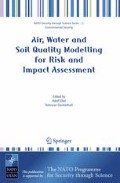Abstract
This paper presents the application of TCAM model to assess secondary pollution control policies. The work focuses on two emission scenarios: the current legislation one, related to the emission reduction established by the EU Directives, and the MFR one, referring to the emission reduction caused by the use of the most efficient available reduction technology for each emission sector. The results show that the impact of both scenarios on ozone mean concentration is limited, even as for AOT40, the reduction reaches the 50% with respect to the base case. The impact on PM10 is more significant, also in terms of mean and exceedance days. Therefore, the impact of both emission control strategies does not meet PM10 EU 2010 standards over the whole domain.
Access this chapter
Tax calculation will be finalised at checkout
Purchases are for personal use only
Preview
Unable to display preview. Download preview PDF.
References
Angelino, E., Bedogni, M., Carnevale, C., Finzi, G., Minguzzi, E., Peroni, E., Pertot, C., Pirovano, G., and Volta, M., 2005, PM10 chemical model simulations over the Milan area in the frame of CityDelta exercise, Proc. of the 5th International Conference on Urban Air Quality, Valencia (E).
Bubnova, R., Horanyi, A., and Malardel, S., 1993, International project ARPEGE/ALADIN. EWGLAM Newsletter, 22: 117–130.
Carnevale, C., Finzi, G., Volta, M., 2005a, Design and validation of a multiphase 3D model to simulate tropospheric pollution. Proc. 44th IEEE Conference on Decision and Control and European Control Conference, CD-ROM, ISBN 0-7803-9568-9.
Carnevale C., Gabusi, V., and Volta, M., 2005b, POEM-PM: an emission modelling for secondary pollution control scenarios, Environmental Modelling and Software, doi:10.1016/j.envsoft.2004.11.003.
Carnevale, C., Finzi, G., and Volta, M., 2005c, Seasonal characterization of secondary aerosol in the Northern Italy using TCAM model, Proc. of the 5th International conference on Urban Air Quality, Valencia (E).
Carter, W., Luo, D., and Malkina, I., 1997, Environmental chamber studies for development of an updated photochemical mechanism for WOV reactivity assessment, Tech. Rep., California Air Resource Board, Sacramento, CA.
Forester, C.K., 1977, Higher order monotonic convection differences schemes, Journal of Computational Physics, 23: 1–22.
Kim, Y.P., Seinfeld, J.H., Saxena, P., 1992, Atmospheric gas aerosol equilibrium, I: thermodynamic model. Aerosol Science and Technology 19, 157–181.
Neftel, A., Spirig, C., Prévôt, A., Furger, M., Stuz, J., Vogel, B., and Hjorth, J., 2002, Sensitivity of photo-oxidant production in the Milan basin: an overview of results from a EUROTRAC-2 Limitation of Oxidant Production field experiment, Journal of Geophysical Research 107(D22).
Pepper, D.W., Kern, C.D., and Long, P.E., 1979, Modelling the dispersion of atmospheric pollution using cubic splines and Chapeau functions, Atmospheric Environment, 13: 223–237.
Scire, J., Insley, E., and Yamartino, R., 1990. Model formulation and user’s guide for the CALMET meteorological model, Tech. Rep. A025–1, California Air Resources Board, Sacramento, CA.
Seinfeld, J.H., and Pandis, S.M., 1998, Atmospheric Chemistry and Physics. John Wiley & Sons.
Simpson, D., Fagerli, H., Jonson, J., Tsyro, S., and Wind, P., 2003. Transboundary, acidification, eutrophication and ground level ozone in Europe – Part I: Unified EMEP model description, Tech. Rep. 1/2003, EMEP MSC-W.
Sun, P., Chock, D.P., and Winkler, S.L., 1994, An Implicit-Explicit Hybrid Solver for a System of Stiff Kinetic Equations. Proc. 87th Air & Waste Management Association Annual Meeting.
Thunis, P., and Cuvelier, C., 2004, CITYDELTA: an European modelling inter-comparison to predict air quality in 2010, in Air Pollution Modelling and its Application XVI, Kluwer Academic/Plenum Publisher pp. 205–214.
Volta, M., and Finzi, G., 2005, GAMES, a comprehensive GAS Aerosol Modelling Evaluation System, Environmental Modelling and Software, doi: 10.1016/-j.envsoft.2004.06.012.
Yamartino, R., Scire, J., Carmichael, G., and Chang, Y., 1992. The CALGRID mesoscale photochemical grid model – I. Model formulation. Atmospheric Environment 26A (8), 1493–1512.
Author information
Authors and Affiliations
Editor information
Editors and Affiliations
Rights and permissions
Copyright information
© 2007 Springer
About this paper
Cite this paper
FINZI, G., CARNEVALE, C., VOLTA, M. (2007). A MULTIPHASE MODEL TO ASSESS THE EFFECTIVENESS OF EMISSION CONTROL SCENARIOS. In: Ebel, A., Davitashvili, T. (eds) Air, Water and Soil Quality Modelling for Risk and Impact Assessment. NATO Security Through Science Series. Springer, Dordrecht. https://doi.org/10.1007/978-1-4020-5877-6_9
Download citation
DOI: https://doi.org/10.1007/978-1-4020-5877-6_9
Publisher Name: Springer, Dordrecht
Print ISBN: 978-1-4020-5875-2
Online ISBN: 978-1-4020-5877-6
eBook Packages: Earth and Environmental ScienceEarth and Environmental Science (R0)

